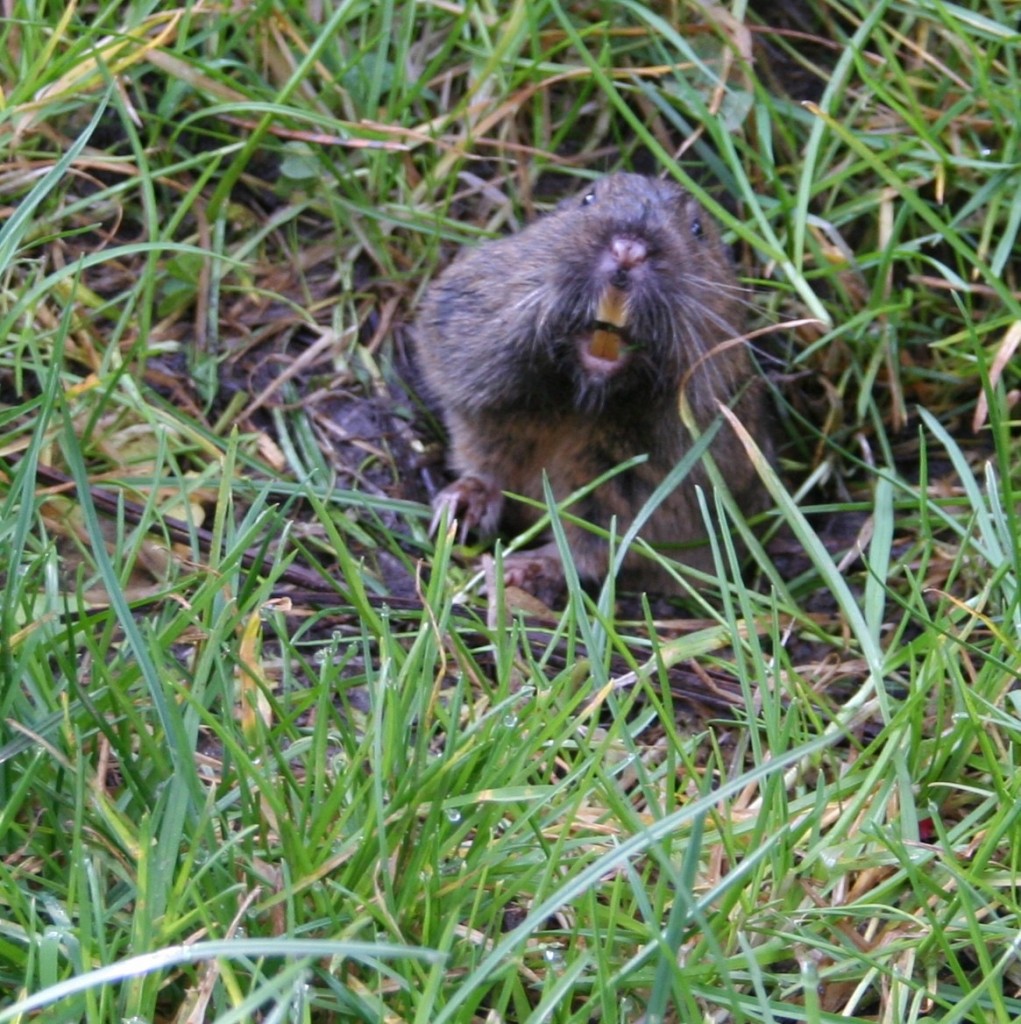
Ah, gophers. So cute, with their cheeks stuffed with grass and their little burrowing ways. Yet so destructive to our vegetable beds.
A client finally got tired of having her beets, lettuces, and other delicious veggies cruelly snatched away by Mr Gopher juuust when they were looking ready to harvest. So we were called in to line the bottom of her bed with gopher wire.
Please, people, learn from these fine people’s mistake, and line your vegetable bed with 1/2 inch hardware cloth before you put the soil in. Because digging up your entire veggie bed to line it afterwards is really kind of lame to have to do.
Anyway, if you’re in the same boat (and many people are), here’s how to line your vegetable bed to keep out gophers, even after the soil’s in. (Click on each photo for a larger version.)
You’ll need:
- 1/2″ hardware cloth, long/wide enough for your bed, plus six inches of overlap if you need to overlap for a wide bed, plus six inches extra on all sides so you can attach it to your vegetable bed.
- hammer
- fencing nails (they’re a curved, staple shape, but very sturdy)
- pig rings (oh, the imagery. My innocence was shattered by the thought of what pig rings are actually for. I don’t think pigs really enjoy the whole having-their-ears-pierced deal.)
- a ringer, to smash the rings into, um, rings
- wire cutters to trim your hardware cloth at the end
Optional:
- an energetic helper, a staple gun, and staples
First, shovel half the soil to the other side of the bed. I went 14″ down from the top, because we’re only planning on shallow-rooted plants in this bed. You might want to go 18″ down for tomatoes, artichokes, and other large veggies.
Next, we unrolled the hardware cloth:
And folded up the edges to help keep it from flying back in our faces. You don’t need to overlap as much as I did here. I had the option of a 3′ or 4′ roll, and 3′ wouldn’t have gotten full coverage. 6″ of overlap should be fine.
We used a staple gun to secure it into place initially, but I had no faith that staples would stay put and not rot out in the first year. So the staples were just to get it secured into place initially so it didn’t shift around as we worked.
Then, we started hammering the fencing nails in for a more permanent way of holding the hardware cloth in place. (Why do they call it “cloth”, anyway? Even the peeps on Project Runway couldn’t make this sharp mess fun to wear!)
Then, we brought out the ringer and pig rings:
The ringer just barely fit into the holes in the hardware cloth. We then put rings through the overlapping sections of cloth every 6″ to hold them together and keep Madame and Mr Gophers out of our nice bed. The fellow at the hardware store said every 8-12″ would do, but let me tell you, I was not about to chance having to dig up all that soil again so I could save ten minutes and $3 worth of pig rings.
Time to work on the other side! I just rolled up the hardware cloth tightly, stepped on it to fold it enough that it’d stay in place while we shoveled soil, then proceeded to move the soil from one side to another. This is where I began to be extra grateful for that previously-mentioned energetic helper!
Finishing the other side went a lot easier since we had the techniques down.
Once you’re all secured and stapled-in, just smooth the soil out again, add whatever amendments you prefer, and plant.
The whole project cost about $140 for a 15′ by 7′ raised bed, and took about 2.5 hours with two people, not including the time I spent finding out what a pig ringer was.
Hope this helps you outwit those rascally buggers and get to eat your own produce this year! If you have any tips for making the project easier or more cost-effective, please let me know in the comments below.
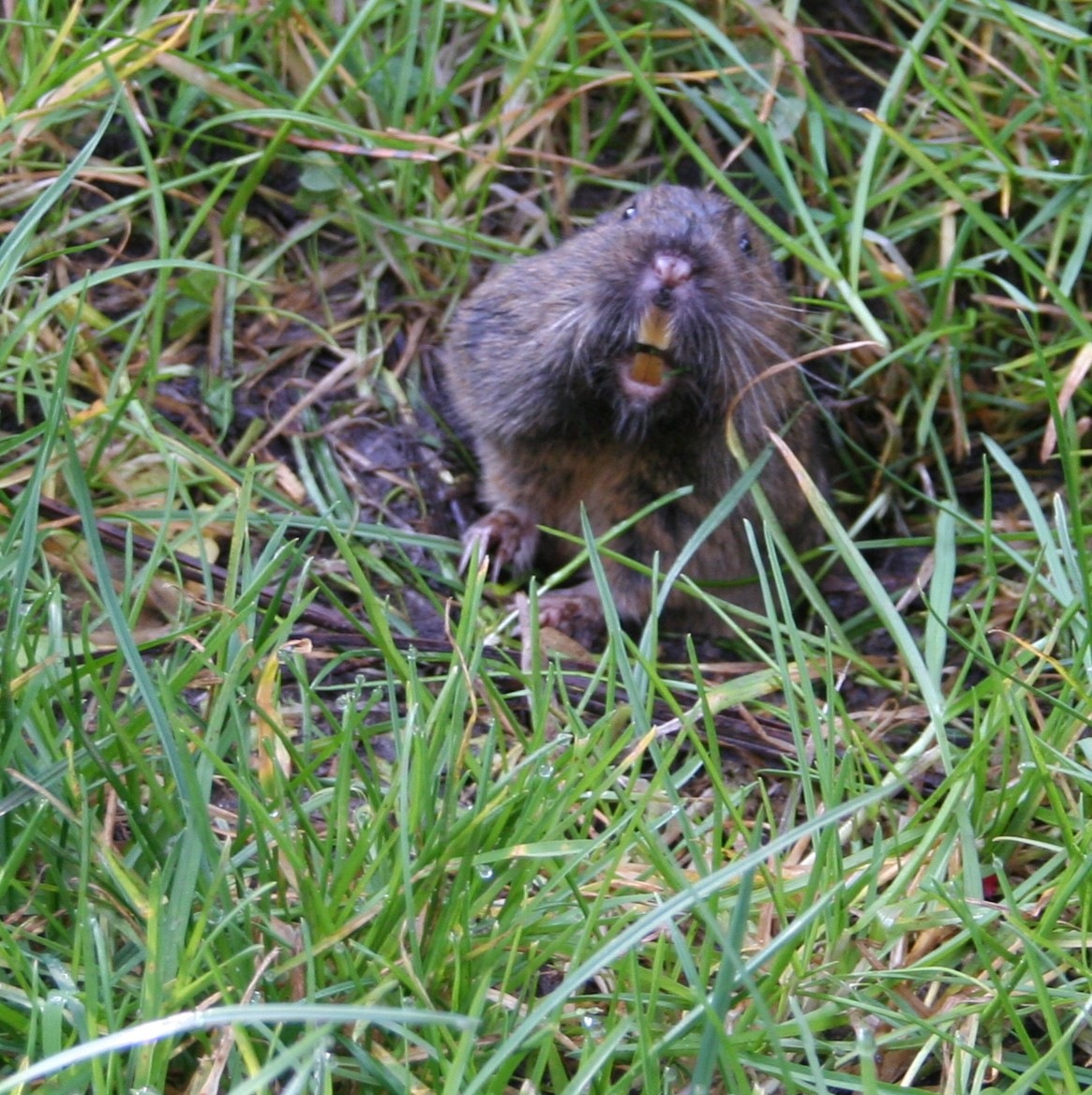
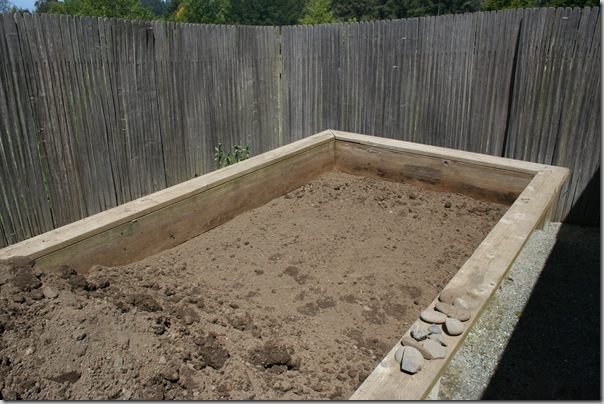

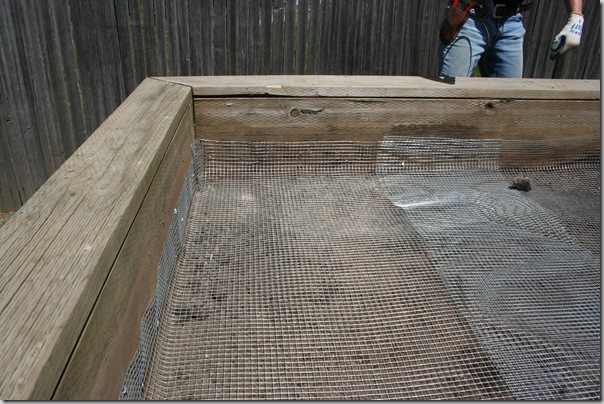

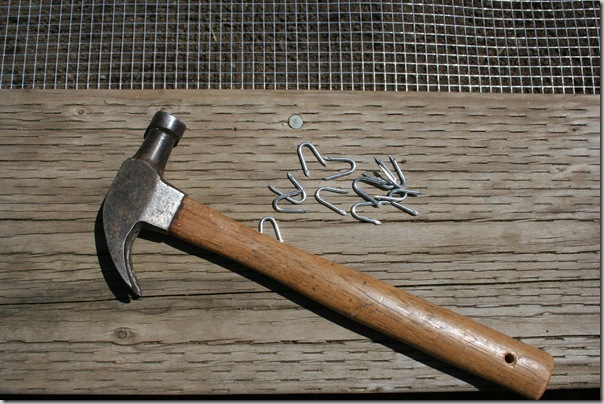

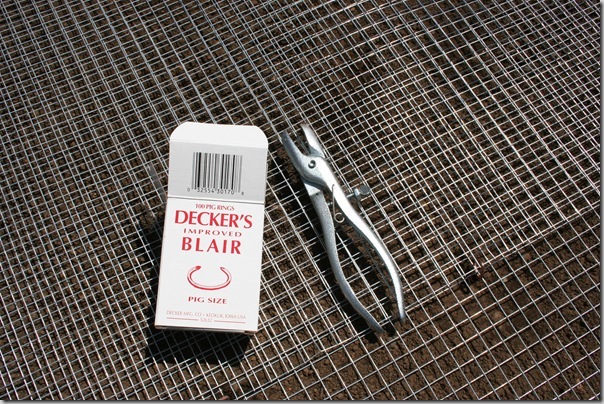
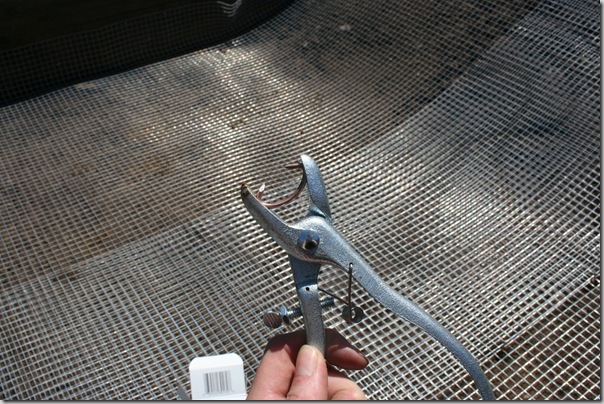

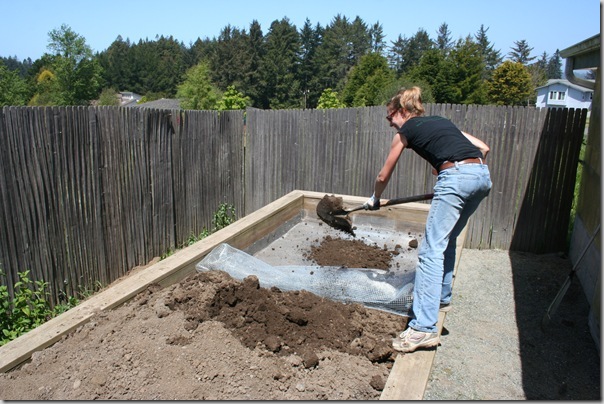
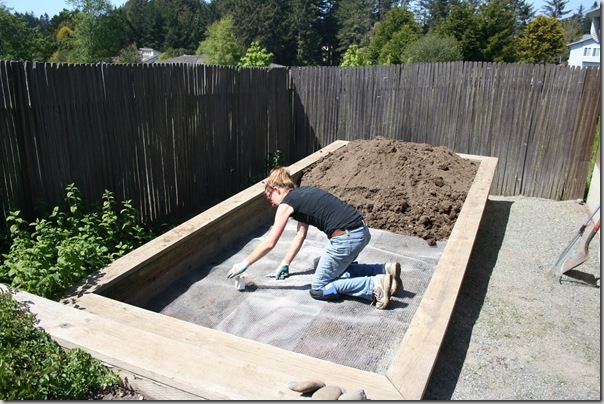
21 responses to “How To Gopher-Proof an Existing Raised Bed (Photo Tutorial)”
We lined our planter beds with hardware cloth when we installed them….It is a lot of work to put them after the fact. We have moles/ Voles in our front yard, we didn’t see signs of activity in the back (where our veg garden is) but did it just in case.
We also had to put hardware cloth cages for our rose bushes that were planted in the front yard.
The bulbs were just planted in the ground the first year, but they never showed up. Now we use a chicken wire mesh.
Giri, yes, best to take the extra effort to line them from the get-go, even if it is a just-in-case measure. Having to go back and do it later is un-fun!
I do the exact same thing with bulbs in gardens with a lot of wildlife! Tulips seem especially beloved by underground critters.
Awesome tutorial Genevieve! I used to have this problem until I got my pug. Not kidding, lol.
Nicky, clearly I need a pug. It took my cats about six months to catch the gopher I had at my house. Six months! Every day my orange cat would come inside with dirt up to his armpits from diving after that crafty bugger. One day I found Mr Gopher under my coffee table – a day of triumph for the kitty. A day of gross cleanup for me.
Thanks for this tutorial. Now I need a tutorial on how to make cages to protect bean plants from rabbits.
Oh Kathy, careful – you’re making me jealous that you have rabbits! I know I’d only be jealous until they ate one of my plants and then I’d be wrathful, but – bunnies! They are so cute!!!
Hello – this is a fantastic tutorial on making a raised bed gopher-proof. I’ve heard there are sonic emitters that repel gophers, moles, and other animals from the vegetable garden, but not sure how well they work.
One thing about lining the bottom of your bed like this is it’s almost guaranteed to be effective.
Those sonic emitters seem to work fairly well, but they’re not foolproof, and I don’t particularly like the sound they make. Kind of disrupts my peace – you can definitely hear them!
I live in the Pahrump NV valley and I have gophers big time! I see them playing across the road. Next thing I see are mounds of dirt on my side of the road and holes. They dug on one side of the fence and came out inside the property on the other side of the fence! I have one sonic emitter and move it around to a new gopher hole. They do work, but I need about six more. I put wire in the bottom of my raised beds and other flower beds. The darn critters climb OVER the raised edge and ate my lettuce. I also noticed stems missing on my potted dahlias.
I actually saw one eating a desert plant with orange flowers this morning. I will place net tents around the lettuce and move the dahlias higher. I had ants nipping off the stems of some potatoe plants, but I sprayed around them and sprinkled insecticide grandules outside the bed. No more ants. I also sprayed the wood good with bug killer.
My gophers are apparently smarter than yours! We installed Europa stone planters with gopher wire in the bottom–the varmints climbed up and entered through the top! We saw them do this on cctv one evening. Now what?!? (Yes, I admit, they are smarter than me, too).
Now I think you’re stuck using traps! What a bummer! I have never heard of that happening, but I guess those crafty varmints will find a way to eat. 🙂
I have six large raised beds with 1/2″ hardware cloth down 18 inches and up the sides of the beds. We have a gopher infestation. As soon as the squash and pumpkin vines went over the sides and touched the ground, the pocket gophers climed the vines into the raised beds. They have already eaten three of the largest plants, beautiful plants but no roots. they are driving me crazy.
I hear ya Dennis. Me too!!! I have a large artichoke plant in a commercial black pot w/a hardware cloth bottom & large holes on the sides near the bottom, also sealed off w/hardware cloth. The other day I went out to check what most recent damage had been done, as I’ve been losing plants daily, even ones in protected pots & lined beds…oh, & yes, they come up out of the ground & dive right into the lined beds & pots & do their deed!!! Anyway, one mound right next to the artichoke pot had an artichoke branch/leaf in it w/the end shredded from the gopher pulling it into his run & dining on it. Crafty is an underestimate of their skill.
where did you buy your hardware cloth? what was the width?
Thanks
I put in hardware cloth like this 7 years ago, as it stopped working. The lower redwood boards completely surrounded by dirt rotted out. The hardware cloth is in shreds. It was galvanized but it still rusted out.
I like the way you dug it out half way put in the cloth then dug the other half. That solves the mystery of where to put all the dirt!
I also think they find their way over the top. It’s worse with the drought as the gophers and others have less and less to eat during the dry times.
THE RINGS GO IN THE PIGGIES NOSE, SWEETIE, NOT THE EARS. THEY KEEP THE PIG FROM “ROOTING”. THAT IS DIGGING WITH THE SNOUT, TO LOOK FOR TASTY ROOTS AND GRUBS. THE DIGGING CAUSES INTENSE FEELINGS OF CONTENTMENT, IN MR. PIGGY, AND INTENSE FRUSTRATION, IN THE FARMER WHOSE FENCE IS NO LONGER CONTAINING PIGS. AS TO THE FEELINGS OF ENVIRONMENTALISTS, EVERYWHERE…. WE’D NEED TO POST A MEME, FOR THAT!
How tall does a raised bed have to be to keep gophers from climbing into it?
[…] If you have raised beds to protect, you might want to check this out. […]
I would not recommend the pressure treated lumber because they use arsenic and chromium. Those are harmful to humans and with time, will leech into your soil and then into your vegetables…
I have a couple of dozen railroad ties. Are they, with their oil treatment, safe to use for raised garden beds?
I would definitely not use railroad ties for a raised bed, if you plan to plant veggies. Railroad ties are coated with several toxic chemicals that can leach into your garden soil. Just think of the smell of walking down a railroad track in the summer heat. The smell makes me feel nostalgic, but it comes from all the tars, oils, preservatives and other toxins that spill off the passing railroad cars.
Best to stick with untreated woods like cedar or even untreated pine. Good luck!